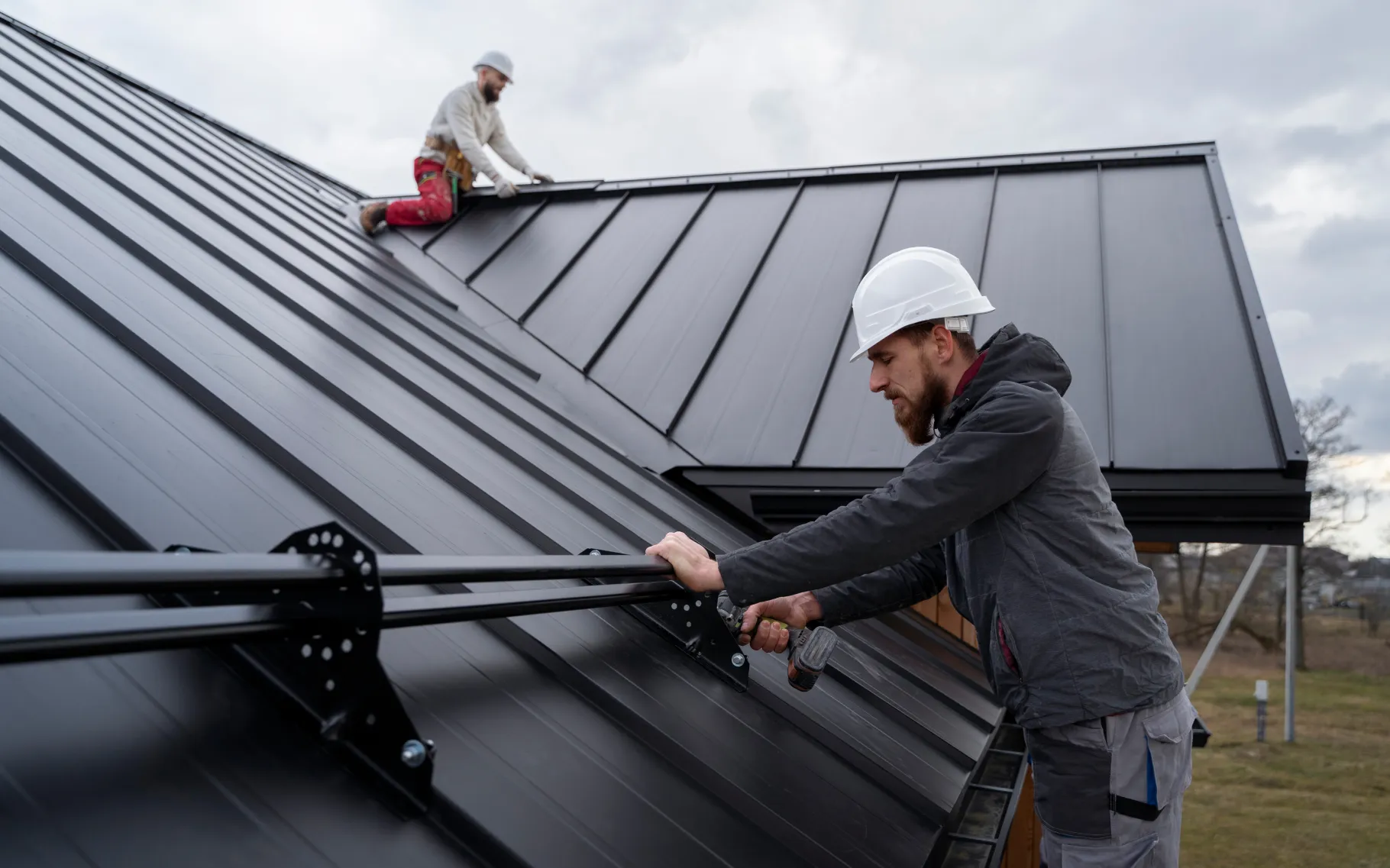When it comes to roofing projects — whether that’s repairing the roof on a single-family home or constructing a new one on a multi-tenant commercial complex — few things are as critical as applying for and obtaining the proper roofing permit.
Adhering to the permitting process means you're complying with local government regulations, keeping project timelines on track, and avoiding costly reworks.
In this article, we’ll discuss what a roofing permit is, why it’s required, how to obtain a roofing permit, and how permit management software can help streamline your roofing projects.
Save time and get roofing permits faster with PermitFlow. Learn more here.
What is a roofing permit?
A roofing permit is a form of authorization from a local government agency that allows you to perform specific roofing work either on an existing structure or a new build. This type of building permit ensures that the work you’re completing complies with the necessary building codes, safety standards, accessibility standards, and zoning laws within your municipality.
Roofing permits are often required for:
- Replacing existing roofs
- Structural repairs that involve trusses or support beams
- Large-scale commercial roofing projects
- Installation of new roofing materials
- Solar-integrated roofing systems
The type of work that necessitates a roofing permit varies depending on the jurisdiction your project is located in. Some cities might require a permit for minor repairs, but others will not.
To learn more about the permitting process in your local municipality, check out our municipal guides.

Does roofing require a permit?
Yes, almost all roofing projects require a permit.
Whether you’re tackling a full roof replacement, major structural repair, or even installing a new roofing system like TPO or metal panels, chances are your local jurisdiction mandates a permit before work begins.
That said, the exact rules depend on your jurisdiction, property type, and scope of work.
Common projects that typically require a permit:
- Full tear-offs and replacements
- Structural work (framing, sheathing, or load-bearing changes)
- Commercial roofing installations
- Re-roofing over existing layers (in many areas)
Projects that may not require a permit:
- Minor residential repairs (e.g. patching shingles or flashing)
- Small-scale maintenance with no structural impact
Local codes vary widely —especially in coastal, snowy, or wildfire-prone regions — so it’s always smart to confirm with your building department.
Why roofing permits are required
Roofing permits are more than paperwork — they’re necessary to ensure safety and code compliance with your local government.
Here’s why they’re important:
- Code compliance: Roofing permits are necessary to enforce local and state building codes. These are designed to ensure structures are safe and habitable.
- Liability protection: Conducting unpermitted work exposes builders and property owners to fines, insurance issues, and potential lawsuits if the work fails or causes any injuries or damages.
- Insurance and resale: Many insurance agencies won’t cover damages caused by unpermitted work. Similarly, when it comes time to sell property, missing permits can delay or derail transactions.
- Inspection requirements: Permits often require inspections before, during, and after the roofing build. This adds an additional layer of quality control, which can delay timelines if not completed in a timely manner.
How to get a roofing permit
Applying for a roofing permit isn’t rocket science — but it can become a paperwork mess if you’re not careful. Between navigating AHJ requirements, gathering the right documents, and tracking approvals, even small errors can lead to costly delays.
Here’s how to get a roofing permit, step by step:
- Research local permit requirements
- Gather documentation
- Submit the permit application
- Pay any permitting fees required
- Await approval
- Schedule and pass inspections
Step 1: Research local permit requirements
Every city, county, and AHJ (authority having jurisdiction) has its own rules about what kind of roofing work requires a permit — and what doesn’t.
For example:
- Residential vs. commercial: Permitting standards are often stricter for commercial jobs.
- Scope of work: Full roof replacements typically require permits, while minor repairs may not.
- Location-specific codes: Areas prone to high wind, heavy snow, or wildfires may require specific roofing materials or fastening methods.
You can usually find permitting details on your city or county website, or by calling the local building department.
Another way to identify roofing permit requirements is to use permit management software like PermitFlow. Permitting software helps you quickly identify what’s required and whether you have the right information before submitting your application. This prevents delays related to mistakes in the application.
Step 2: Gather documentation
Submitting incomplete or incorrect documents is one of the primary reasons permits get delayed or rejected.
Be sure to collect:
Step 3: Submit the permit application
With everything assembled, you’re ready to file.
Depending on the jurisdiction, you may have to:
- Submit through an online permitting portal
- Email the application to a designated plan reviewer
- Deliver the paperwork in person at the building department
This is another area where permit management software can help streamline the process. Submit your application using permit software so you can track its status and increase your chances of a quick approval.
Step 4: Pay the roofing permit fees
Roofing permit fees vary widely based on:
- Project size and value
- Residential vs. commercial classification
- Local fee structures (flat fee, per square foot, or value-based)
Typical roofing permit costs range from $150–$1,000+, though commercial roofing jobs can exceed that range depending on scope. Some jurisdictions also charge separate plan check or inspection fees.
Pro tip: Ask whether there are additional fees if you’re pulling the permit as a subcontractor or for work involving structural upgrades.
Step 5: Await approval
Plan review timelines depend on your jurisdiction’s backlog and the complexity of your project.
- Simple reroof on a home? You might get approved in a few days.
- Large-scale commercial job? It could take a few weeks or more.
Any issues with your application — like missing documents, incorrect license info, or lacking details around the project scope — can reset the clock. That’s why many contractors use permit management software to catch errors before submission.
Step 6: Schedule and pass inspections
Roofing inspections are typically required at one or more stages, including:
- Pre-roof or tear-off: Ensures the roof deck is in acceptable condition.
- Mid-roof (optional): Sometimes required for complex assemblies or insulation layers.
- Final inspection: Verifies installation matches approved plans and meets code.
You'll usually have to schedule inspections through your local building department or online portal. In some areas, missing or failing inspections can void your permit or delay certificate of occupancy (CO).
How permit management software simplifies roofing permits
Manually managing several roofing permits can be an organizational and logistical nightmare for builders, developers, and other construction businesses juggling multiple projects. Adopting permit management software like PermitFlow can help streamline the roofing permitting process.
Key features of permit management software:
- Centralized permit tracking: View all permit statuses, documents, and deadlines in one dashboard.
- Real-time notifications: Get immediate alerts for submission updates, missing documentation, or inspection dates
- Smart templates: Reduce manual data entry with autofill forms and templates.
- Jurisdiction research: Access local requirements for each project site, which can save hours of research.
- Collaboration tools: Easily share documents and updates with contractors, inspectors, and project managers.
Streamline your roofing permit process with PermitFlow
Whether you’re overseeing a residential or commercial roofing project, understanding and managing the roofing permit process is key to a successful build.
By adding PermitFlow into your permitting process, you can transform a traditionally complex process into a trackable and streamlined workflow.
Learn how PermitFlow can help you build faster. Talk to one of our permitting experts today.








